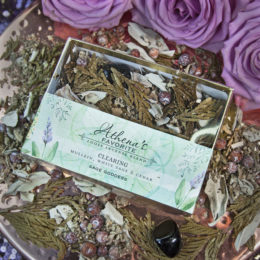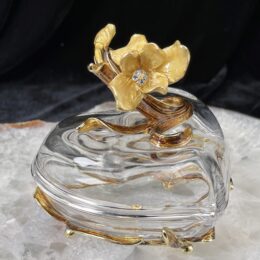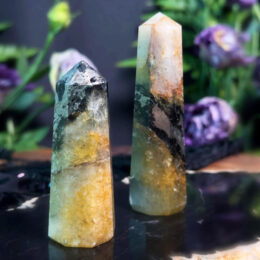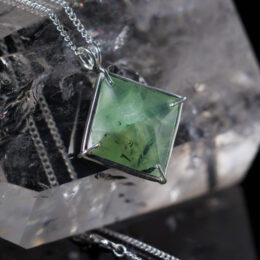Your cart is currently empty!
Ammonite Guide: Properties and Meaning
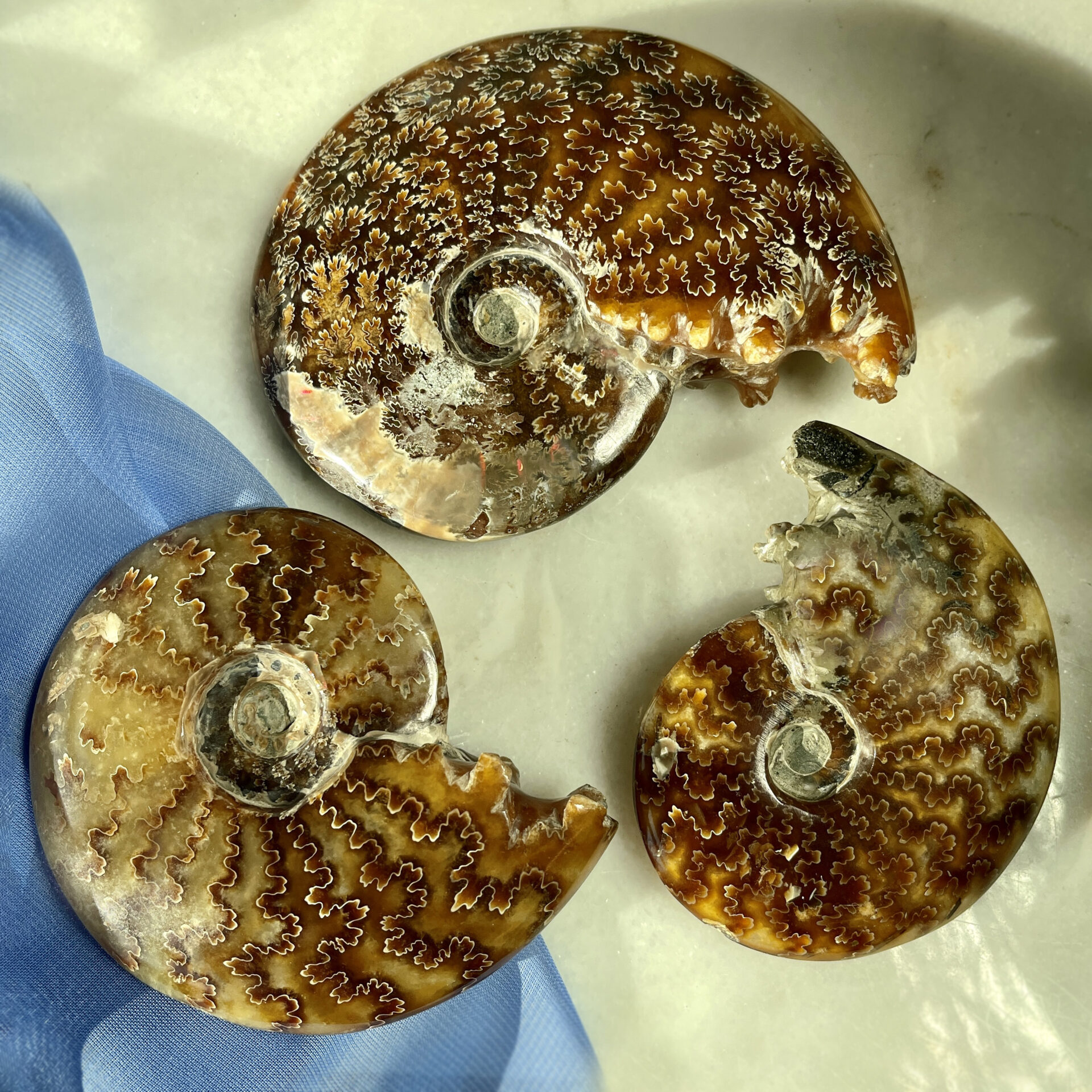
Ammonite Properties
Color: GrayMohs Hardness: 4Chakra: All ChakrasCrystal Structure:hexagonalLocation: United Kingdom, Germany, Morocco
About Ammonite
Ammonite is a fossilized creature that lived 400 million years ago and represents the Fibonacci sequence. It is a versatile stone for spiritual healing, known for its ability to balance and align all chakras. The Ammonite symbolizes the never-ending stream of consciousness that connects one to the source, making it an excellent stone for meditation. Its color ranges from brown to black, and its intricate spiral patterns are often revealed through polishing. Ammonite is a unique and powerful stone that helps individuals connect with their inner selves and the universe.
The history of Ammonite
Ammonite has a rich history that dates back millions of years. These fossilized creatures were once abundant in the Earth’s oceans and are named after the Egyptian god Amun, who was often depicted wearing ram horns, resembling the spiral shape of the Ammonite. The spiral patterns of the Ammonite represent the Fibonacci sequence, a mathematical pattern found in nature. This ancient stone has been revered by various cultures throughout history for its spiritual and healing properties. Today, Ammonite continues to be cherished for its beauty and its ability to connect individuals with the past and the present.
What are the healing properties of Ammonite?
Ammonite balances and aligns all chakras, making it a versatile stone for spiritual healing.
What are the metaphysical/spiritual properties of Ammonite?
Ammonite represents the fibonacci sequence and symbolizes the never-ending stream of consciousness that connects one to the source. It is an excellent stone for meditation, helping individuals connect with their inner self and the universe.
What is the color of Ammonite?
The color of Ammonite varies from brown to black.
How is Ammonite often polished?
Ammonite is often polished to reveal its intricate spiral patterns.
What is Ammonite?
Ammonite is a fossilized creature that lived 400 million years ago.
Ammonite FAQ
What is Ammonite used for?
Ammonite is used for various purposes, including jewelry making, home decor, and as a collectible item. Its unique spiral shape and vibrant colors make it a popular choice for creating stunning pendants, earrings, and bracelets. Additionally, Ammonite fossils are often used as decorative pieces in homes and offices, adding a touch of natural beauty to any space.
What does Ammonite do?
Ammonite possesses powerful healing properties. It promotes stability and grounding, helping individuals find balance in their lives. Ammonite also enhances creativity and stimulates the flow of energy, making it a valuable tool for artists and those seeking inspiration. Furthermore, it brings good luck and prosperity to its wearer, attracting abundance and success.
Can Ammonite go in water?
Ammonite is a fossilized shell, and while it is generally safe to handle, it is not recommended to submerge it in water. Water can potentially damage the delicate structure of the fossil and cause it to deteriorate over time. It is best to keep Ammonite dry and clean it using gentle methods, such as wiping it with a soft cloth or brushing it with a soft-bristled toothbrush.
How to cleanse Ammonite?
To cleanse Ammonite, you can use various methods. One common method is to place the fossil in a bowl of dry sea salt or bury it in a container filled with salt. Leave it overnight to absorb any negative energies. Another method is to cleanse it with smoke from sacred herbs, such as sage or palo santo. Simply pass the Ammonite through the smoke while setting your intention to purify and cleanse it. Remember to always handle Ammonite with care and avoid using harsh chemicals or abrasive materials.
What does Ammonite do spiritually?
Ammonite has strong spiritual properties. It assists in past life regression and helps individuals connect with their ancestral roots. Ammonite also enhances intuition and psychic abilities, allowing for a deeper understanding of oneself and the world around them. Additionally, it promotes spiritual growth and transformation, aiding in the release of old patterns and facilitating personal evolution.
How to clean Ammonite?
To clean Ammonite, it is important to handle it gently and avoid using harsh chemicals or abrasive materials. You can start by wiping it with a soft, damp cloth to remove any dirt or dust. If there are stubborn stains or debris, you can use a soft-bristled toothbrush to gently brush them away. Avoid immersing Ammonite in water or exposing it to excessive moisture, as this can potentially damage the fossil.
How to spot fake Ammonite?
To spot fake Ammonite, there are a few key factors to consider. Genuine Ammonite fossils have distinct spiral patterns and intricate chambers, while fake ones may lack these details or have them poorly replicated. Additionally, real Ammonite fossils often have a natural iridescence or shimmer, whereas imitations may appear dull or lackluster. It is also important to purchase Ammonite from reputable sources to ensure its authenticity.
Is Ammonite toxic?
Ammonite is not toxic and is generally safe to handle. However, it is important to note that Ammonite fossils are delicate and can break or chip if mishandled. It is recommended to handle Ammonite with care and avoid exposing it to extreme temperatures or excessive pressure to prevent any potential harm.
Where is Ammonite found?
Ammonite fossils are found in various parts of the world, including North America, Europe, and Asia. They are often discovered in sedimentary rocks, such as shale or limestone, which were once ancient seabeds. Some notable locations for Ammonite fossils include the coasts of Madagascar, Morocco, and Alberta, Canada.
How is Ammonite pronounced?
Ammonite is pronounced as “AM-uh-nite.” The emphasis is placed on the first syllable, and the “o” is pronounced as a short vowel sound, similar to the word “lot.”
What chakra is associated with Ammonite?
Ammonite is commonly associated with the Root Chakra, also known as the Base Chakra. This energy center is located at the base of the spine and is associated with grounding, stability, and a sense of security. Ammonite helps balance and activate the Root Chakra, promoting a strong foundation and a connection to the Earth’s energy.
Can Ammonite be in the sun?
Ammonite can be safely exposed to sunlight. In fact, sunlight can enhance the natural colors and iridescence of the fossil, making it even more visually appealing. However, it is important to avoid prolonged exposure to direct sunlight, as it can potentially fade or damage the fossil over time. It is best to display Ammonite in a location where it receives indirect sunlight or in a well-lit area of your home.
How to charge Ammonite?
To charge Ammonite, you can place it in direct sunlight or moonlight for a few hours. Sunlight infuses the fossil with vibrant energy and vitality, while moonlight enhances its intuitive and spiritual properties. As you expose Ammonite to the light, set your intention for the energy you wish to imbue it with, whether it is for healing, creativity, or personal growth.
What is the hardness of Ammonite?
Ammonite fossils have a hardness of around 4 on the Mohs scale. This means they are relatively soft and can be easily scratched or damaged by harder materials. It is important to handle Ammonite with care and avoid exposing it to rough surfaces or abrasive substances that could potentially scratch or chip the fossil.



